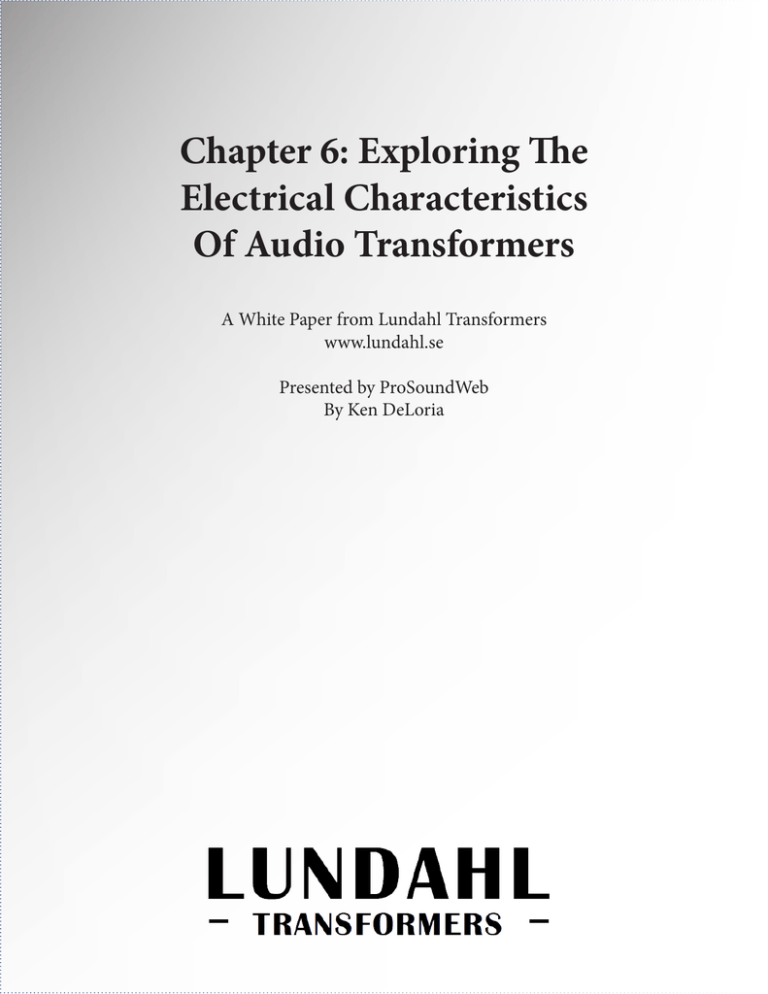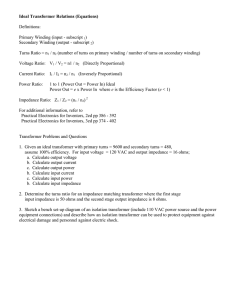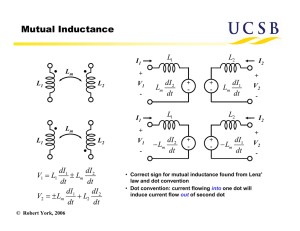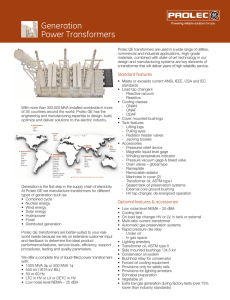Chapter 6: Exploring The Electrical Characteristics Of
advertisement

Chapter 6: Exploring The Electrical Characteristics Of Audio Transformers A White Paper from Lundahl Transformers www.lundahl.se Presented by ProSoundWeb By Ken DeLoria In the previous chapters of this series, we’ve discussed various transformer-related applications with an emphasis on why audio transformers are unique among electrical components in their ability to provide 100 percent galvanic isolation. In this chapter we’re going to explore the basic electrical characteristics of audio transformers to better understand the differences among various types, and why one transformer is better for a given application than another. There are four important properties to consider. These are: • • • • Primary impedance / Primary inductance LP Copper wire resistance in windings R Leakage inductance LL Internal capacitance CT A transformer is a passive device. Thus, its behavior in any given application is dependent upon the source and load that are connected to it. All transformers have a primary impedance value which is largely a function of the inductance of the windings, determined by the transformer’s design. The primary input impedance can be low or high, but in audio applications it should be significantly larger than the impedance of the load (as seen through the transformer) in the required frequency range. In the schematics below, primary impedance is labeled Lp, where the L represents inductance and the p represents primary. Therefore, Lp simply means “primary inductance.” Next, there is always internal resistance from the transformer’s copper windings. This is labeled R. Third, all transformers exhibit internal leakage inductance, labeled LL. Finally, transformers also exhibit internal capacitance, which is labeled CT. The schematic in Figure 1 (above) illustrates a simplified electrical equivalency circuit of these properties, each represented by familiar discreet components that together make up the characteristics of a transformer’s electrical behavior. For those unfamiliar with equivalency circuits these are not external components that should be used with the transformer, but rather, they serve to show what’s taking place inside the transformer by breaking down the fundamentals into separate ”equivalent circuits.” Chapter 6: Exploring The Electrical Characteristics of Audio Transformers Page 2 of 7 www.lundahl.se In addition, the properties depicted in the equivalency circuits are actually distributed within the transformer itself, but for discussion purposes they can be represented as discrete components. As you can see, the primary inductance and the internal capacitance are in parallel with the load, whereas the copper resistance and the leakage inductance are in series with the load. In many applications the above equivalent circuit can be simplified additionally. If the load impedance is high, the leakage inductance can be ignored, as illustrated in Figure 2 (below). The model in Figure 3 (below) illustrates the opposite of Figure 2. When RL, the load impedance is low, the influence of the internal capacitance is minimal, and can thus essentially be ignored. All Transformers Are Not Created Equal An optimal transformer design must take into account the specific application, as well as any anticipated variations of the ‘normal’ practices that the transformer design is intended for. While it’s certainly useful to test and characterize a given transformer by measuring its frequency and phase response on the test bench with a fixed input and output impedance, the measured results will provide only a piece of the complete picture. Performance will alter as the source and load impedances change; this is a basic fact of physics. In many applications it may not be possible to always know in advance what the input and output impedances will actually be, a normal condition that rental companies face every day. Moreover, source or load impedances (usually load) might change on- the-fly as additional devices are paralleled together during a system configuraChapter 6: Exploring The Electrical Characteristics of Audio Transformers Page 3 of 7 www.lundahl.se tion change. Or, the source impedance alters because one output device is substituted for another. In cases such as these, which are absolutely common in real-world practices, a given transformer’s response, in respect to frequency, phase, signal handling capability and distortion, might be quite different than that of its published response curves. It is therefore prudent to choose transformers that will continue to behave linerially – even when source and load impedances alter – so that system changes can be accomodated without compromising audio quality. Balancing Parameters We’ve established that the impact of a transformer’s leakage inductance and internal capacitance will vary in respect to source and load impedance. That now begs the question, “What can be done to minimize these effects?” To start with, a transformer’s leakage inductance and capacitance are a function of the interleaving of the primary and secondary windings: more interleaving (usually referred to as “sectioning”) results in less leakage inductance but more capacitance. Less sectioning, and the opposite occurs: more leakage inductance but less capacitance. The short answer is that optimal performance ties directly to the design decisions that were made when the transformer was conceived, prototypes were built, and subsequent production units were manufactured. There is no magic bullet. Nonetheless, developing a superior transformer product is not a random event; it is the result of expertly balancing all electrical and mechanical parameters – which include frequency and phase response, bandwidth, signal handling, and distortion – to best meet the specific application that the design was intended for. Optimal transformer design, and superior quality manufacturing processes, are the result of many years of engineering development. The Perfect Transformer In an ideal situation you would want Lp (primary impedance) to be infinite and R, LL and CT to be zero. If they were, you could ignore the influence of the transformer on your circuit design. Of course this is not possible. Restrictions such as size and signal level capability – not to mention cost – must be factored into the design. Size is an important and often determining factor; a small transformer cannot handle high signal levels unless high copper resistance is accepted, whereas a large transformer with more iron cannot fit into many products, especially not small devices such as microphones or in-line XLR isolation “barrels.” Moreover, each of the properties discussed above are inextricably linked to one another. An alteration made to one property will change all the others, and normally in an unfavorable direction. Design Variables Copper wire resistance in the transformer’s windings causes a signal drop because it is a resistance in series with the load. A way to reduce the copper resistance is to use fewer turns of wire. However, this will reduce the transformer’s signal level capability while also reducing the primary inductance value. If the primary inductance (impedance) is not high enough compared to the (transformed) impedance of the Chapter 6: Exploring The Electrical Characteristics of Audio Transformers Page 4 of 7 www.lundahl.se load, there will be an LF roll-off. To increase the transformer inductance you can increase the number of turns of wire. But that will also increase the transformer’s internal copper-wire resistance. In high impedance applications (mostly input situations) the CT must not be too large, as it is in parallel with the load and will cause an HF roll-off. Given a reduction in CT you can reduce the sectioning of the transformer. Sectioning is the extent to which the primary and secondary windings are interleaved, but if you reduce sectioning then LL, the leakage inductance, will increase. In low impedance applications (mostly outputs) the leakage inductance must be kept small because it’s in series with the load and will cause an HF drop. You can increase the sectioning to reduce leakage inductance, but at the cost of increased CT. This begins to look like an equation that is impossible to solve. Making It Possible When one carefully considers the interplay of tradeoffs that must be addressed in balancing one parameter against another, it becomes clear the task requires engineering knowledge coupled with years of skilled, empirical research experience. The decades of design and development work that have led to Lundahl’s success are indeed the foundation of that success. There is no substitute for time spent, nor for the passion that has relentlessly driven the R&D efforts of the company. When a customer explains their specific application and requirements, the task is to select a transformer type that balances each of the parameters for optimal performance. In some cases a stock model may be a perfect fit. For other applications the optimal solution may require a custom design of a completely new model. When all design parameters have been expertly balanced in relation to a specific application, it is normally possible to find a solution in which you can almost ignore the transformer properties throughout the audio frequency spectrum, and even throughout an extension of the spectrum. However, finding the best transformer for your particular application, when constraints such as size, shape, budget, etc., are present – and they always are – is extremely difficult to accomplish without an engineering partner that possesses the depth of understanding of how to balance achievable performance against ”wish lists,” ultimately achieving the desired end-result. Windings Are Everything As noted in previous chapters, the nature of any transformer’s windings are critical to its performance capability. Sloppy windings equal inferior performance. It’s simple magnetics. Let’s briefly recap Lundahl’s winding technique. Unlike most – in fact nearly all transformer manufacturers around the world – Lundahl use a technique called stick winding. Other manufacturers use round bobbins that are wound on readily available machinery. Lundahl does not. Instead, the company winds copper wire around “sticks” that range in size from very small (for microChapter 6: Exploring The Electrical Characteristics of Audio Transformers A Lundahl winding machine performing stick winding. Page 5 of 7 www.lundahl.se phones) to about the size of a pack of gum (and larger) for applications that have less limited size restrictions. NOTE: All other factors being equal, larger transformers can handle higher signal levels than smaller ones before core saturation occurs. This is due to the greater content of metal in the transformer’s core. Saturation results in an immediate rise in distortion and should always be avoided. One of the many advantages of Lundahl’s stick winding technique is that it yields a smaller size for a given performance specification, along with an OEM-friendly form-factor. Form factor is very important in confined spaces. Obviously, most microphones do not have room for large transformers. Other applications are spacesensitive as well. These include direct boxes, 500 Series modules, outboard preamplifiers and limiters (especially tube-based), and in-line isolators. Lundahl manufactures an XLR-XLR isolation transformer in a “barrel” package (pictured below) that accepts full line level signals, exhibits excellent specs, posesses superb sound quality, and is no larger than a typical XLR-XLR ground lift or phase-reverser. There is no disadvantage to stick winding other than that Lundahl has had to design and build all of its own manufacturing machinery, control electronics, and machine-control software. But ultimately that works out to be an advantage, as the company is able to control the entire process from raw materials to finished goods. And with control comes a level of quality and uniformity that’s integrated into Lundahl’s core philosophy of achieving maximally obtainable sonic transparency. Many subtleties are present in manufacturing transformers and each plays an important role in how the end product will perform. Not the least is maintaining uniformity in the windings. Lundahl manufacturers its own winding machines in order to optimally control winding tolerances, wire tension, winding speed, and other critical parameters. Below are some examples of how precision transformers can solve various common problems. Long Lines Large systems often require very long lines to interconnect one branch of the system to another. Permanent installations in sports venues, large festivals, temporary events with broadcast and recording trucks positioned in the parking lot, and numerous other applications, all require very long audio lines. When driving long lines it’s important that LL, the leakage inductance, is kept low. Otherwise a resonance between the cable capacitance and the transformer leakage inductance may occur. This problem is commonly solved with bifilar wound output transformers, but can also be solved with highly sectioned output transformers, which will provide uncompromised electrical insulation and superior common mode rejection compared to the bifilar technique. Chapter 6: Exploring The Electrical Characteristics of Audio Transformers Page 6 of 7 www.lundahl.se Free Gain When a signal source exhibits very low impedance, compared to the input impedance of the preamplifier or amplifier that it’s driving (e.g., ribbon mic elements and moving coil cartridges fit this description), a step-up transformer can provide the much-needed voltage gain…almost for free. Of course, in the strictest technical sense gain is not actually added (the transformer remains a passive device), but apparent gain occurs due to the improved matching of the input impedance to the source and the output impedance to the load. Impedance Matching & Voltage Step-Up Impedance is a measure of the relationship between voltage and current. When discussing output impedance, a low value (normally desired) indicates how well a source can maintain a certain voltage under different loads. In particular it indicates how well the voltage can be maintained even if the load impedance drops. A high input impedance (normally desired) indicates how easily, or how little current is required, for a source to reach a certain voltage across the input. Some signal sources, in particular ribbon microphone motors and moving coil cartridges, have an impedance level that is much lower than optimal. In addition, they also have a very low output voltage and require substantial voltage gain to overcome noise in the line and in the preamp. With the use of a step-up transformer the small voltage signal can be increased noise-free by 20-30 dB (or more) by trading the very low source impedance to a still acceptable medium impedance output. Other signal sources, such as electron tubes, have plenty of voltage swing but too high of a source impedance to work well in audio systems. In this case, a step-down transformer is used to reduce the source impedance, but at the cost of voltage swing. As should now be clear, the humble transformer – which seems so simple on a schematic diagram – is anything but. The numerous parameters that must be juggled during the design phase require significant knowledge to comprehend, and a wealth of experience to optimize. The commitment that Lundahl has made to manufacturing what are arguably the most transparent and effective transformers available anywhere in the world, is the result of Per Lundahl, and his father before him, walking the path of no compromise. Per Lundahl: “A question often raised is if Lundahl provides an output transformer for matching consumer audio products to pro audio systems. A step-up of 14 dB is normally required. However, as the output impedance of many consumer audio products is in the range of 1K, a 14 dB step-up would increase the impedance to 25K, which is too high to drive a line without the risk of noise pickup. We’d rather miss out on a sizeable market opportunity than make something we know is not optimal.” Chapter 6: Exploring The Electrical Characteristics of Audio Transformers Page 7 of 7 www.lundahl.se




